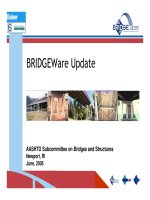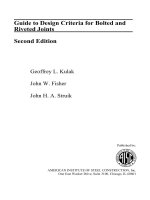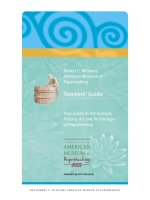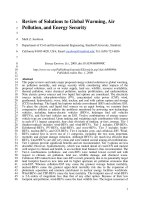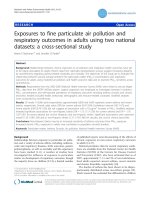bridge to abstract math - mathematical proof and structures, 1st ed. - r. morash
Bạn đang xem bản rút gọn của tài liệu. Xem và tải ngay bản đầy đủ của tài liệu tại đây (10.55 MB, 413 trang )
THE RANDOM
HBUSEIBIRKHAUSER
MATHEMAT
.
.,!
,
-,
-
<:.
7
.,
-
. .
1
-
.
-
. .
-
.,
. .
. .
MATH
EI-YTICS
MATHEMATICAL
PROOF
AND
STRUCTURES
BRIDGE
TO ABSTRACT
MATHEMATICS
Mathematical
Proof
and
Structures
The Random House/Birkhaoser Mathematics Series:
INVITATION TO COMPLEX ANALYSIS
by
R.
P.
Boas
BRIDGE TO ABSTRACT MATHEMATICS:
MATHEMATICAL PROOF AND STRUCTURES
by Ronald
P.
Morash
ELEMENTARY NUMBER THEORY
by Charles Vanden Eynden
INTRODUCTION TO ABSTRACT ALGEBRA
by Elbert Walker
BRIDGE
TO
ABSTRACT
MATHEMATICS
Mathematical
Proof
and
Structures
Ronald
E
Morash
University of Michigan, Dearborn
The Random House/Birkhauser Mathematics Series
Random House, Inc.
&
New York
First Edition
Copyright
@
1987 by Random House, Inc.
All rights reserved under International and Pan-American Copyright
Conventions. No part of this book may
be
reproduced in any form or by any
means, electronic or mechanical, including photocopying, without permission in
writing from the publisher. All inquiries should
be
addressed to Random House,
Inc., 201 East 50th Street, New York, N.Y. 10022. Published in the United
States by Random House, Inc., and simultaneously in Canada by Random
House of Canada Limited, Toronto.
i
Library of Congress Cataloging in Publication Data
Morash, Ronald
P.
Bridge to abstract mathematics.
Includes index.
1.
Logic, Symbolic and mathematical.
2. Mathematics
-1961-
.
I.
Title.
QA9.M74 1987 511.3 86-21931
ISBN 0-394-35429-X
Manufactured in the United States of America
to
my
family
Preface
This text is directed toward the sophomore through senior levels of uni-
versity mathematics, with a tilt toward the former. It presumes that the
student has completed at least one semester, and preferably a full year, of
calculus. The text is a product of fourteen years of experience, on the part
of the author, in teaching a not-too-common course to students with a very
common need. The course is taken predominantly by sophomores and
juniors from various fields of concentration who expect to enroll in junior-
senior mathematics courses that include significant abstract content. It
endeavors to provide a pathway, or bridge, to the level of mathematical
sophistication normally desired by instructors in such courses, but generally
not provided by the standard freshman-sophomore program. Toward this
end, the course places strong emphasis on mathematical reasoning and ex-
position. Stated differently, it endeavors to serve as a significant first step
toward the goal of precise thinking and effective communication of one's
thoughts in the language of science.
Of
central importance in any overt attempt to instill "mathematical ma-
turity" in students is the writing and comprehension of proofs. Surely, the
requirement that students deal seriously with mathematical proofs is the
single factor that most strongly differentiates upper-division courses from
the calculus sequence and other freshman-sophomore classes. Accordingly,
the centerpiece of this text is a substantial body of material that deals
explicitly and systematically with mathematical proof (Article
4.1,
Chapters
\
5 and
6).
A primary feature of this material is a recognition of and reliance
on the student's background in mathematics (e.g., algebra, trigonometry,
calculus, set theory) for a context in which to present proof-writing tech-
niques. The first three chapters of the text deal with material that is impor-
tant in its own right (sets, logic), but their major role is to lay groundwork
for the coverage of proofs. Likewise, the material in Chapters
7
through
10
(relations, number systems) is of independent value to any student going
on in mathematics. It is not inaccurate, however, in the context of this
book, to view it primarily as a vehicle by which students may develop
further the incipient ability to read and write proofs.
PREFACE
vll
IMPORTANT FEATURES
Readability.
The author's primary pedagogical goal in writing the text was
to produce a book that students can read. Since many colleges and uni-
versities in the United States do not currently have a "bridging" course in
mathematics, it was a goal to make the book suitable for the individual
student who might want to study it independently. Toward this end, an in-
troduction is provided for each chapter, and for many articles within chap-
ters, to place content in perspective and relate it to other parts of the book,
providing both an overall point of view and specific suggestions for work-
ing through the unit. Solved examples are distributed liberally through-
out the text. Abstract definitions are amplified, whenever appropriate, by
a number of concrete examples. Occasionally, the presentation of material
is interrupted, so the author can "talk to" the reader and explain various
mathematical "facts of life." The numerous exercises at the end of articles
have been carefully selected and placed to illustrate and supplement ma-
terial in the article. In addition, exercises are often used to anticipate results
or concepts in the next article. Of course, most students who use the text
will do so under the direction of an instructor. Both instructor and students
reap the benefit of enhanced opportunity for efficient classroom coverage
of material when students are able to read a text.
Organization.
In Chapter
1,
we introduce basic terminology and notation
of set theory and provide an informal study of the algebra of sets. Beyond
this, we use set theory as a device to indicate to the student what serious
mathematics is really about, that is, the discovery of general theorems.
Such discovery devices as examples, pictures, analogies, and counterexam-
ples are brought into play. Rhetorical questions are employed often in this
chapter to instill in the student the habit of thinking aggressively, of looking
for questions as well as answers. Also, a case is made at this stage for both
the desirability of a systematic approach to manipulating statements (i.e.,
logic) and the necessity of abstract proof to validate our mathematical
beliefs.
In Chapters
2
and
3,
we study logic from a concrete and common-sense
point of view. Strong emphasis is placed on those logical principles that
are most commonly used in everyday mathematics (i.e., tautologies of the
propositional calculus and theorems of the predicate calculus). The goal
of these chapters is to integrate principles of logic into the student's way
of thinking so that they are applied correctly, though most often only
implicitly, to the solving of mathematical problems, including the writing
of proofs.
In Chapter
4,
we begin to some mathematics, with an emphasis on
topics whose understanding is enhanced by a knowledge of elementary
logic. Most important, we begin in this chapter to deal with proofs, limiting
ourselves at this stage to theorems of set theory, including properties of
viii
PREFACE
countably infinite collections of sets. The main emphasis here is on stan-
dard approaches to proving set inclusion (e.g., the "choose" method) and
set equality (e.g., mutual inclusion), but we manage also, through the many
solved examples, to anticipate additional techniques of proof that are stud-
ied in detail later. The chapter concludes by digressing to an optional, and
perhaps somewhat offbeat, second look at the limit concept, directed to-
ward an understanding of the epsilon-delta definition.
Chapters 5 and 6 provide the text's most concentrated treatment of proof
writing per se. The general organization of these chapters is in order of
increasing complexity, with special emphasis on the logical structure of
the conclusion of the proposition to be proved.
In Articles 5.1, 5.2, and
6.1, we progress from conclusions with the simplest logical structure [i.e.,
(Vx)(p(x))], to conclusions with a more complex form [i.e., (b'x)(p(x)
+
q(x))], and then to the most complex case
[V
followed by 31. Additional
techniques, including induction, indirect proof, specialization, division into
cases, and counterexample, are also studied. Solved examples and exercises
calling for the writing of proofs are selected from set theory, intermediate
algebra, trigonometry, elementary calculus, matrix algebra, and elementary
analysis. Of course, instructors must gear the assignment of exercises to
the students' background. Solved examples, toget her with starred exercises
(whose solutions appear in the back of the book) provide numerous models
of proofs, after which students may pattern their own attempts. An ad-
ditional source of correctly written proofs (as well as some that were de-
liberately written incorrectly) is a "Critique and Complete" category of
exercise that occurs in Article
4.1
and throughout Chapter 5.
Chapters
7
and
8
deal with the most common kinds of relations on sets,
equivalence relations, partial orderings, and functions. Chapter
8
includes
an introduction to cardinality of sets and a brief discussion of arbitrary
collections of sets. Chapters
9
and 10 study the standard number systems
encountered in undergraduate mathematics. Chapter
9
emphasizes the
properties that distinguish the real numbers from other familiar number
systems. Chapter 10 provides an outline of an actual construction of the
real numbers, which would perhaps be most appropriately used in a class
of seniors or as an independent study project for a well-motivated and
relatively advanced student. In addition to treating material that is of con-
siderable value in its own right, Chapters
7
through 10 provide ample
opportunity for students to put into practice proof-writing skills acquired
in earlier chapters. In keeping with the advancing abilities of students,
proofs are deliberately written in an increasingly terse fashion (with less
detailed explanation and less psychological support) in the later chapters.
This may provide a smooth transition from this text to the "real world" of
typical texts for standard junior-senior courses.
Flexibility.
Bridging courses in mathematics are by no means an estab-
lished or standardized part of the undergraduate curriculum. Indeed,
PREFACE
ix
among colleges and universities where such courses exist, the subject matter
varies considerably. For this reason, an attempt has been made to include
in this text a wide variety of topics and to avoid interdependence among
topics whenever possible. Furthermore, a conscious decision was made to
avoid any primary focus on material that is the specific content of main-
stream junior-senior courses.
A
number of articles in Book One
(1.5,2.4,3.5,4.3,6.3,6.4)
are designated
"optional." The nonoptional material in Book One (i.e., Articles 1.1
-
1.4,
2.1-2.3, 3.1-3.4, 4.1, 4.2, 5.1-5.4, 6.1, and 6.2) constitutes what the author
regards as the core content for achieving the objectives of a bridging course
and for permitting passage to Book Two. Though no topics in Book Two
have been explicitly designated as optional, they can be covered selectively
to fit the needs of a particular course. Many different syllabi can be based
on this text, depending on the number of available class sessions, the initial
level of the students, and the judgment of individual instructors or curric-
ulum committees. For example, a two-credit course focused on sets, logic,
and proof could cover the core material from Book One.
A
three-credit
course for sophomores, in which a relatively leisurely pace and strong focus
on fundamentals is desired, might proceed:
[Core plus 1.5, 2.4, 3.51
-+
[Ch. 71
+
C8.1, 8.21
[Core plus 2.4, 4.3, 6.1
(E
-
6
proofs)]
+
C7.1, 7.2, 7.31
+
C8.1, 8.21.
Possibilities for three-credit courses with a more advanced or accelerated
point of view include:
[Core plus 1.5, 2.4, 6.31
+
[Ch. 71
-,
[Ch. 81
and
[Core plus 6.31
-+
C7.1, 7.2, 7.31
-+
[Ch.
91
-+
[lo.
11.
A
number of alternative syllabi are contained in the instructor's manual,
available free from the publisher to instructors using the text. This manual
also provides a list of objectives for each article, as well as commentary on
pedagogical issues related to various portions of the text.
ACKNOWLEDGMENTS
A
large number of people contributed in iniportant ways to the inception,
development, and completion of this text. First among these was my editor
at Random HouselBirkhauser, Wayne Yuhasz, without whose early en-
couragement my
set
of class notes would have remained in that state.
I
am indebted to him also for highly professional support, as the project
progressed.
1
x
PREFACE
We began the project with an extensive survey of opinions about the
teaching of mathematical proof writing, and we want to thank all who
shared their thoughts and experiences:
William Berlinghoff, Southern
John Lawlor, University of
Connecticut State University Vermont
Charles Biles, Humboldt State
Douglas Nance, Central Michigan
University University
Richard Chandler, North Carolina
Gregory B. Passty, Southwest
State University Texas State University
Orin Chein, Temple University
Bradd Clark, University of
Southwestern Louisiana
William Coppage, Wright State
University
Carl Cowen, Purdue University
Robert G. Dean, Stephen F.
Austin University
Gail Ratliff, University of
Missouri, St. Louis
Robert B. Reisel, Loyola
University of Chicago
Donald F. Reynolds, Indiana
State University
David Sprows, Villanova
University
Thomas Den=, Ashland College
Louis A. Talman, Metropolitan
State College
Michael Evans, North Carolina
State University
Raymond
D.
Terry, California
Polytechnic State University
Daniel Farkas, Virginia
Polytechnic and State
Richard Thompson, University of
university Arizona
Dorothy Goldberg, Kean College
James
Vance, Wright
State
of New Jersey University
Joel Haack, Oklahoma State
University
Robert W. West, University of
California, Irvine
Kenneth E. Hummel, Trinity
University
\,
The suggestions of many reviewers had a strong influence on the devel-
opment of the manuscript.
I
would like to thank Professors William
Berlinghoff, Charles Biles, Orin Chein, Robert Dean, Michael Evans, Joel
Haack, John Lawlor, David Sprows, Richard Thompson, and James Vance,
for an extraordinarily conscientious job of reviewing, criticizing, enhancing,
and sometimes praising my work.
In
particular, Professors Biles, Evans,
and Vance provided material, including several fine exercises, that
I
incor-
porated into the text.
I
am grateful to Professor Berlinghoff and his stu-
dents at Southern Connecticut State University, who used a late version
of the manuscript in their course and made a number of helpful suggestions.
PREFACE
xi
Colleagues and students at the University of Michigan, Dearborn, de-
serve thanks for important suggestions and feedback. Professors Stephen
Milles, James Ward Brown, Frank Papp, Michael Lachance, and Manuel
Esteban, as well as Larry Polnicky, were of particular help. Sandra Flack
and Joyce Moss of the U. M. D. mathematics department provided clerical
support, for which
I
am grateful.
Helene Neu, of the University of Michigan, Ann Arbor, gave me much
advice and many helpful insights, as did Professors Ted Giebutowski and
Keith Ferland of Plymouth State College in Plymouth, New Hampshire,
and Dr. Robert Haberstroh of Computervision in Woburn, Massachusetts.
Special thanks for valuable support and encouragement go to my friends
and colleagues in biomedical research, Dr. Ruth Maulucci and Dr. Richard
Eckhouse, of MOCO, Inc., Scituate, Massachusetts.
Finally,
I
would like to take this opportunity to thank two of my own
teachers from my years as a Ph. D. candidate at the University of
Massachusetts, Amherst: Dr. Samuel S. Holland, Jr., and Dr. David
J.
Foulis. Professor Holland, who directed my doctoral dissertation, taught
me a great deal about doing mathematics but, through his example, even
more about teaching mathematics and writing it. Professor Foulis not onlyq
influenced my research in that period through his pioneering work in the
field of orthomodular lattice theory, but also introduced me to the concept
of a bridging course for undergraduates through his excellent text, Funda-
mental Concepts of Mathematics.
RONALD
P.
MORASH
October
1986
University
of
Michigan, Dearborn
Contents
BOOK ONE The Foundation: Sets, Logic,
and Mathematical Argument
SETS
3
Basic Definitions and Notation
4
Operations on Sets
15
Algebraic Properties of Sets
29
Theorems of Set Theory
39
Counting Properties of Finite Sets (Optional)
42
LOGIC, PART
I:
THE PROPOSITIONAL CALCULUS
52
Basic Concepts of the Propositional Calculus
53
Tautology, Equivalence, the Conditional, and Biconditional
59
Theorems of the Propositional Calculus
64
Analysis of Arguments for Logical Validity, Part I (Optional)
76
LOGIC, PART 11: THE PREDICATE CALCULUS
81
Basic Concepts of the Predicate Calculus
82
Quantification
88
Theorems About Predicates in One Variable
95
Quantification of Propositional Functions in Several Variables
101
Analysis of Arguments for Logical Validity, Part
I1
(Optional)
110
ELEMENTARY 'APPLICATIONS OF LOGIC
11s
Applications of Logic to Set Theory-Some Proofs
115
Infinite Unions and Intersections
124
The Limit Concept (Optional)
128
METHODS OF MATHEMATICAL PROOF,
PART
1:
ELEMENTARY
METHODS
146
Conclusions Involving
V,
but Not
3
or
+.
Proof by Transitivity
148
Conclusions Involving
V
and
+,
but Not
3
160
CONTENTS
xiii
Proof by Specialization and Division into Cases
170
Proof by Mathematical Induction
178
METHODS OF MATHEMATICAL PROOF,
PART
11:
ADVANCED METHODS
190
Conclusions Involving
V,
followed by
3
(Epsilon-Delta Proofs Optional)
190
Indirect Proofs
204
Existence and Uniqueness (Optional)
212
Preview of Additional Advanced Methods of Proof (Optional)
222
BOOK TWO Bridging Topics: Relations, Functions,
and Number Systems
RELATIONS, PART
I:
EQUIVALENCE RELATIONS
AND
PARTIAL ORDERINGS
227
Relations
228
Equivalence Relations
235
Equivalence Classes and Partitions
240
Partial Ordering
245
RELATIONS, PART
Ik
FUNCTIONS
AND MAPPINGS
252
Functions and Mappings
252
More on Functions and Mappings-Surjections, Bijections, Image,
and Inverse Image
266
Cardinal Number of a Set
277
Arbitrary Collections of Sets
289
PROPERTIES OF THE NUMBER SYSTEMS
OF UNDERGRADUATE MATHEMATICS
293
Fields
294
Ordered Fields
303
Completeness in an Ordered Field
310
Properties of the Complex Number Field
319
CONSTRUCTION OF THE NUMBER SYSTEMS
OF UNDERGRADUATE MATHEMATICS
329
An
Axiomatization for the System of Positive Integers
330
Development of the Integers and Rational Numbers
343
Outline of a Construction of the Reds
352
Answers and Solutions to Selected Exercises
362
List
of
Symbols
380
Index
383
TO
ABSTRACT
MATHEMATICS
Mathematical
Proof
and
Structures
ONE
The
Foundation:
Sets,
Logic,
and
Mathematical Argument
CHAPTER
1
The purpose of this chapter is twofold: to provide an introduction to, or
review of, the terminology, notation, and basic properties of sets, and,
perhaps more important, to serve as a starting point for our primary
goal-the development of the ability to discover and prove mathematical
theorems. The emphasis in this chapter is on
discovery,
with particular
attention paid to the kinds of evidence (e.g., specific examples, pictures) that
mathematicians use to formulate conjectures about general properties.
These conjectures become theorems when the mathematician provides a
rigorous proof (methods of proof start in Chapter 4).
The information on set theory contained in this chapter is important in
its own right, but the spirit of discovery-proceeding with caution from
the particular to the possibly true general, which we emphasize in discussing
sets-applies to all areas of mathematics and is indeed what much of mathe-
matics is about! We will continue to stress its importance in later chapters,
even as we concentrate increasingly on the mechanics of theorem-proving.
The formal development of set theory began in 1874 with the work of
Georg Cantor
(1
845- 19 18). Since then, motivated particularly by the dis-
covery of certain paradoxes (e.g., Russell's paradox, see Exercise lo), logi-
cians have made formal set theory and the foundations of mathematics a
vital area of mathematical research, and mathematicians at large have in-
corporated the language and methods of set theory into their work, so that
it permeates all of modern mathematics. Formal, or axiomatic, set theory is
not normally studied until the graduate level, and appropriately so. But
the undergraduate student of mathematics at the junior-senior level needs
a good working knowledge of the elementary properties of sets, as well as
facility with a number of set theoretic approaches to proving theorems. As
stated earlier, our treatment of the latter begins in Chapter 4. Here we en-
courage you to develop the habit of making conjectures about potential
4
SETS
Chapter
1
theorems of set theory, as suggested by the various types of evidence you
encounter.
1.
Basic Definitions and Notation
The notion of set is a primitive, or undefined, term in mathematics, anal-
ogous to point and line in plane geometry. Therefore, our starting point,
rather than a formal definition, is an informal description of how the term
"set" is generally viewed in applications to undergraduate mathematics.
REMARK
1
A
set
may be thought of as a well-defined collection of objects.
The objects in the set are called
elements
of the set.
The elements of a set may be any kinds of objects at all, ranging from,
most familiarly, numbers to names of people, varieties of flowers, or names
of states in the United States or provinces in Canada.
A
set may even have
other sets as some or all of its elements (see Exercise
9).
We will adopt the convention that capital letters A, B, X,
Y,
are used to
denote the names of sets, whereas lowercase a, b, x,
y,
denotes objects viewed
as possible elements of sets. Furthermore, the expression a
E
A (E is the
Greek letter "epsilon" in lower case) represents the statement "the object
a is an element of the set A," and x
4
X represents the assertion that the
object x is
not
an element of the set X. The convention about the use of
upper- and lowercase letters may occasionally be dispensed with in the text
when inconvenient (such as in an example in which an element of a given
set is itself a set). However, it is especially valuable and will be adhered to
in setting up proofs of theorems in later chapters.
One advantage of having an informal definition of the term set is that,
through it, we can introduce some other terminology related to sets. The
term element is one example, and the notion well-defined is another. The
latter term relates to the primary requirement for any such description:
Given an object, we must be able to determine whether or not the object lies
-
in the described set. Here are two general methods of describing sets; as we
will soon observe,
method.
METHODS
OF
well-definedness has a particular bearing on the second
DESCRIBING SETS
The roster method.
We describe a set by listing the names of its elements,
separated by commas, with the full list enclosed in braces. Thus A
=
(1,2,3,4) or
B
=
(Massachusetts, Michigan, California) are sets consist-
ing of four and three elements, respectively, described by the roster method.
Note that 2
E
A and Michigan
E
B, but
5
4
A and Ohio
4
B.
1.1
BASIC DEFINITIONS AND NOTATION
5
Two important facts are: (1) the order in which elements are listed is
irrelevant and (2) an object should be listed only once in the roster, since
listing it more than once does not change the set. As an example, the set
{
1, 1,2) is the same as the set {1,2) (so that the representation (1, 1,2)
is never used) which, in turn, is the same as the set (2, 1).
The rule, or description, method.
We describe a set in terms of one or more
properties to
be
satisfied by objects in the set, and by those objects only.
Such a description is formulated in so-called
set-builder
notation, that is,
in the form
A
=
{x
1
x satisfies some property or properties), which we read
"A
is the set of all objects x such that x satisfies
.
. .
."
Typical representa-
tions of sets by the rule method are:
C
=
{x
1
x is a natural number and x
5
100.)
or
D
=
{x
1
x is the name of a state in the United States beginning
with the letter
M.)
or
X
=
{x lx is a male citizen of the United States.)
In all these examples the vertical line is read "such that" and the set is un-
derstood to consist of
&
objects satisfying the preceding description, and
only those objects. Thus
57
E
C, whereas 126
4
C. The set D can also be
described by the roster method, namely, as the set {Maine, Maryland,
Massachusetts, Michigan, Minnesota, Missouri, Mississippi, Montana).
Although it's true that Maine
E
D, it would be false to say that
D
=
{Maine);
that is, the description of D must not be misinterpreted to mean that
D
has
only one element. The same is true of the set
X
which is a very large set,
difficult to describe by the roster method.
It is in connection with the description method that "well definedness"
comes into play. The rule or rules used in describing
a
set must be (1) mean-
ingful, that is, use words and/or symbols with an understood meaning
and (2) specific and definitive, as opposed to vague and indefinite. Thus
descriptions like
G
=
{x(x is a goople) or
E
=
{xlx!*
&
3) or
Z
=
{xlx is
a large state in the United States) do not define sets. The descriptions of
.
G
and
E
involve nonsense symbols or words, while the description of
Z
gives a purely subjective criterion for membership.
On
the other hand, a set
may be well defined even though its membership is difficult to determine or
not immediately evident from its description (see Exercise 3).
COMPARISON OF THE ROSTER AND RULE METHODS.
FINITE AND INFINITE SETS
The roster method has the obvious advantage of avoiding the problem of
deciding well definedness. Whenever it's used (provided the objects named
as elements have meaning), there can be no doubt as to which objects are,
6
SETS
Chapter
1
and are not, in the set. On the other hand, if the set to be described is
large, the roster method can
be
impractical or impossible to employ. Clearly
we would want to describe the set
F
=
{xlx is a natural number and
x
2
lo8) by the rule method, although it's theoretically possible to list all
the elements, whereas the set
I
=
(x (x is a real number and 0
2
x
5
1)
cannot even theoretically be described by the roster method. Until we give
a rigorous, or mathematically correct, definition in Article 8.3, we will view
an
infinite set
as one that cannot, even theoretically, be described by the
roster method. Stated differently, the elements of an infinite set are impos-
sible to exhaust, and so cannot be listed. A
finite set,
on the other hand, is one
that is not infinite. The set
F,
defined earlier, is finite, whereas
I
is infinite
since it has the property that, between any two distinct elements of
I,
there
is another element of
I.
A set may fail to have this property and still be
infinite; the set of all positive integers is infinite because, whenever
n
is a
positive integer, so is
n
+
1.
A widely used hybrid of the roster and rule methods is employed to de-
scribe both finite and infinite sets. The notation Q
=
(1, 3, 5, . .
.
,97, 99)
or T
=
(10, 20, 30, 40,
.
.
.)
implicitly uses the rule method by establish-
ing a
pattern
in which the elements occur. It uses the appearance of the
roster method, with the symbol
"
.
. .
"
being read "and so on" in the case
of an infinite set such as T and
"
. . .
,
"
meaning "and so on, until" for a
finite set like Q. As with any application of the rule method, there is a
danger of misinterpretation if too little or unclear information is given. As
one example, the notation (1, 2,
.
.
.)
may refer to the set (1, 2, 3,4, 5, . .
.)
of all positive integers or to the set (1, 2, 4, 8, 16, .
.
.)
of all nonnegative
powers of
2.
On the other hand, given the earlier pattern descriptions of
Q and T, most readers would agree that 47
E
Q, 2
&
Q,
50
E
T, 50''
E
T,
and
15
#
T.
There is one other important connection between the roster method and
the rule method. In a number of mathematical situations
solving
a
problem
means essentially to convert a description of a set by the rule method into
a roster method description. In this context we often refer to the roster
representation as the
solution set
of the original problem (see Exercise 1).
UNIVERSAL
SETS
Although the idea of a "universal set" in an absolute sense, that is, a set
containing all objects, leads to serious logical difficulties (explored in
Ex-
ercise 10) and so is not used in set theory, the concept, when applied in a
more limited sense, has considerable value. For our purposes a
universal
set
is the set of all objects under discussion in a particular setting.
A universal set will often be specified at the start of a problem in-
volving sets (in this text the letter
U
will be reserved for this purpose),
whereas in other situations a universal set is more or less clearly, but
implicitly, understood as background to a problem. We did the latter when
